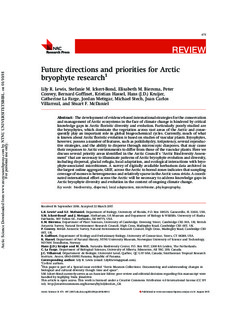| dc.contributor.author | Lewis, Lily R. | |
| dc.contributor.author | Ickert-Bond, Stefanie M. | |
| dc.contributor.author | Biersma, Elisabeth M. | |
| dc.contributor.author | Convey, Peter | |
| dc.contributor.author | Goffinet, Bernard | |
| dc.contributor.author | Hassel, Kristian | |
| dc.contributor.author | Kruijer, Hans J.D. | |
| dc.contributor.author | La Farge, Catherine | |
| dc.contributor.author | Metzgar, Jordan | |
| dc.contributor.author | Stech, Michael | |
| dc.contributor.author | Villarreal, Juan Carlos | |
| dc.contributor.author | McDaniel, Stuart F. | |
| dc.date.accessioned | 2018-01-31T14:44:15Z | |
| dc.date.available | 2018-01-31T14:44:15Z | |
| dc.date.created | 2018-01-10T14:27:22Z | |
| dc.date.issued | 2017 | |
| dc.identifier.citation | Arctic Science. 2017, 3 (3), 475-497. | nb_NO |
| dc.identifier.issn | 2368-7460 | |
| dc.identifier.uri | http://hdl.handle.net/11250/2481069 | |
| dc.description.abstract | The development of evidence-based international strategies for the conservation and management of Arctic ecosystems in the face of climate change is hindered by critical knowledge gaps in Arctic floristic diversity and evolution. Particularly poorly studied are the bryophytes, which dominate the vegetation across vast areas of the Arctic and consequently play an important role in global biogeochemical cycles. Currently, much of what is known about Arctic floristic evolution is based on studies of vascular plants. Bryophytes, however, possess a number of features, such as poikilohydry, totipotency, several reproductive strategies, and the ability to disperse through microscopic diaspores, that may cause their responses to Arctic environments to differ from those of the vascular plants. Here we discuss several priority areas identified in the Arctic Council’s “Arctic Biodiversity Assessment” that are necessary to illuminate patterns of Arctic bryophyte evolution and diversity, including dispersal, glacial refugia, local adaptation, and ecological interactions with bryophyte-associated microbiomes. A survey of digitally available herbarium data archived in the largest online aggregate, GBIF, across the Arctic to boreal zones indicates that sampling coverage of mosses is heterogeneous and relatively sparse in the Arctic sensu stricto. A coordinated international effort across the Arctic will be necessary to address knowledge gaps in Arctic bryophyte diversity and evolution in the context of ongoing climate change. | nb_NO |
| dc.language.iso | eng | nb_NO |
| dc.publisher | NRC Research Press (Canadian Science Publishing) | nb_NO |
| dc.rights | Navngivelse 4.0 Internasjonal | * |
| dc.rights.uri | http://creativecommons.org/licenses/by/4.0/deed.no | * |
| dc.title | Future directions and priorities for Arctic bryophyte research. | nb_NO |
| dc.type | Journal article | nb_NO |
| dc.type | Peer reviewed | nb_NO |
| dc.description.version | publishedVersion | nb_NO |
| dc.source.pagenumber | 475-497 | nb_NO |
| dc.source.volume | 3 | nb_NO |
| dc.source.journal | Arctic Science | nb_NO |
| dc.source.issue | 3 | nb_NO |
| dc.identifier.doi | 10.1139/as-2016-0043 | |
| dc.identifier.cristin | 1539908 | |
| dc.description.localcode | This article is open access. This work is licensed under a Creative Commons Attribution 4.0 International License (CC BY 4.0). http://creativecommons.org/licenses/by/4.0/deed.en_GB. | nb_NO |
| cristin.unitcode | 194,31,10,0 | |
| cristin.unitname | Institutt for naturhistorie | |
| cristin.ispublished | true | |
| cristin.fulltext | original | |

